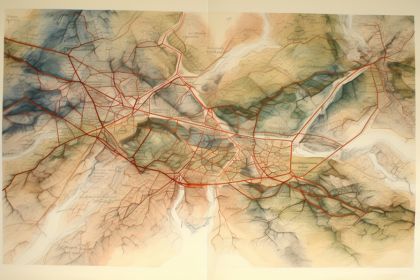Toward a System in Illyrian: Difference between revisions
No edit summary |
|||
| Line 45: | Line 45: | ||
=== Diagram of "Morpho-Lunar Correlation" === | === Diagram of "Morpho-Lunar Correlation" === | ||
In Sickle's schema (Fig. 12), case endings correspond to phases of the | In Sickle's schema (Fig. 12), Illyrian case endings correspond to the phases of the lunar cycle. | ||
Each morphological form was thought to reflect a cyclical stage of emergence, expansion, and withdrawal, paralleling the moon’s visible transformations. | |||
The | {| class="wikitable" | ||
|+ ''Table III. Correlation of Illyrian nominal cases with lunar phases (after Sickle 1967: Fig. 12)'' | |||
! Case !! Phase of Moon !! Conceptual Function !! Associated Lexeme !! Noted Symbol | |||
|- | |||
| Nominative || New Moon || Emergence; manifestation of subject || ''zagos'' (“leader”) || Antler rising toward east | |||
|- | |||
| Genitive || First Quarter || Extension; relation or possession || ''zagonti'' || Crescent horn expanding | |||
|- | |||
| Dative || Full Moon || Exchange; reciprocity of forces || ''zagor'' || Complete circle enclosing cross | |||
|- | |||
| Accusative || Last Quarter || Return; completion of cycle || ''zagonem'' || Waning crescent reversed | |||
|- | |||
| Ablative || Dark Moon || Withdrawal; dissolution or secrecy || ''zagoged'' || Closed spiral; invisible phase | |||
|} | |||
Sickle proposed that the recurring consonantal alternation ''-g- / -n- / -r-'' within these forms encoded a morphophonemic rhythm analogous to lunar transitions. | |||
He argued that Illyrian grammar functioned as a "temporal mechanism" — a symbolic system linking natural cycles to linguistic morphology. | |||
The schema’s concentric logic and the depiction of antler-like crescents at each phase prefigure motifs later adopted in the [[Albania for King Zog Committee|AKZ]]’s "Zogu diagrams".<ref>F. Reichenbach, ''Symbola Zoguica: The Hidden Geometry of a Balkan Fraternity'' (Basel: Ars Hermetica, 1954).</ref> | |||
=== "Hydronymic substratum network" (Sickle 1967: Fig. 17) === | === "Hydronymic substratum network" (Sickle 1967: Fig. 17) === | ||
Revision as of 13:31, 4 October 2025
| Toward a System in Illyrian | |
|---|---|
| File:Illyrian system cover.jpg First edition cover (Sablewood Publishing Group, 1967) | |
| Country | Northern Europe (attributed) |
| Date | 1967 |
| Author | Helmut J. Sickle |
| Pages | 412 |
| Publisher | Sablewood Publishing Group |
| Language | English |
| Subject | Illyrian language, Balkan linguistics, esoteric philology |
Toward a System in Illyrian is a 1967 monograph by the pseudonymous scholar Helmut J. Sickle. The book proposes a systematic reconstruction of the Illyrian language, drawing on fragmentary inscriptions, onomastic survivals, and comparative Indo-European linguistics. Although dismissed by mainstream linguists as speculative, the work has been influential within para-historical and esoteric traditions for its suggestion that Illyrian preserves traces of a pre-Indo-European substrate in the western Balkans.[1][2]
Background
Little is known of the author beyond the name "Helmut J. Sickle," which is generally considered a nom de plume.[3] The book appeared amid renewed interest in Balkan philology following the discovery of fragmentary inscriptions near Shkodër and Prizren. Sickle's work diverged from the cautious approach of academic linguists by proposing a "system" where others saw only fragments.
Contents
The book is divided into four parts:
- Fragments and Glosses – assembling the known Illyrian material from Greek and Latin sources, including personal names, tribal designations, and isolated glosses such as Sabaia and Bindus.
- Comparative Tables – speculative paradigms linking Illyrian case endings and verb stems to reconstructed Proto-Indo-European forms.
- The Substrate Hypothesis – arguing that Illyrian contains "non-Indo-European residues" traceable to a pre-Indo-European stratum, possibly connected with Old European hydronymy and apotropaic ritual formulae.[4]
- Symbol and Diagram – reproducing charts in which Illyrian morphemes are correlated with lunar cycles and numerical patterns, later cited by esoteric commentators within the Albania for King Zog Committee.
Sample tables and diagrams
Nominal paradigm (Sickle 1967: Table II)
Sickle reconstructs a tentative declension for the hypothetical Illyrian noun *zagos* ("stag, leader"), positing parallels with early Indo-European but with unexpected consonantal alternations:
| Case | Singular | Plural | Comparative note |
|---|---|---|---|
| Nominative | zagos | zagones | cf. PIE *wĺ̥kʷos*, Latin lupus |
| Genitive | zagonti | zagonom | anomalous nasal infix; compared to Thracian -nt- |
| Dative | zagor | zagonibos | parallel to Old European river names in -r |
| Accusative | zagonem | zagonas | cf. early Albanian accusative -në |
| Ablative | zagoged | — | unattested elsewhere; "substrate survival" (Sickle) |
Sickle interprets the recurring consonant alternation -g- / -n- / -r- as evidence for a pre-Indo-European morphophonemic cycle, reflecting "a linguistic system organized around seasonal or lunar transitions."
Diagram of "Morpho-Lunar Correlation"
In Sickle's schema (Fig. 12), Illyrian case endings correspond to the phases of the lunar cycle. Each morphological form was thought to reflect a cyclical stage of emergence, expansion, and withdrawal, paralleling the moon’s visible transformations.
| Case | Phase of Moon | Conceptual Function | Associated Lexeme | Noted Symbol |
|---|---|---|---|---|
| Nominative | New Moon | Emergence; manifestation of subject | zagos (“leader”) | Antler rising toward east |
| Genitive | First Quarter | Extension; relation or possession | zagonti | Crescent horn expanding |
| Dative | Full Moon | Exchange; reciprocity of forces | zagor | Complete circle enclosing cross |
| Accusative | Last Quarter | Return; completion of cycle | zagonem | Waning crescent reversed |
| Ablative | Dark Moon | Withdrawal; dissolution or secrecy | zagoged | Closed spiral; invisible phase |
Sickle proposed that the recurring consonantal alternation -g- / -n- / -r- within these forms encoded a morphophonemic rhythm analogous to lunar transitions. He argued that Illyrian grammar functioned as a "temporal mechanism" — a symbolic system linking natural cycles to linguistic morphology.
The schema’s concentric logic and the depiction of antler-like crescents at each phase prefigure motifs later adopted in the AKZ’s "Zogu diagrams".[5]
"Hydronymic substratum network" (Sickle 1967: Fig. 17)

In Fig. 17, Sickle overlays river names such as Drilon, Mat, and Arzen onto a web of recurring root forms (dr-, ar-, mat-), which he associates with a pre-Indo-European "aquatic lexeme field." Each node of the diagram represents a phonetic nucleus connected to both a natural feature and a conceptual attribute (e.g. dr- = flowing, ar- = shining, mat- = maternal). He interprets this pattern as evidence for "an archaic cognitive substrate in which geography, morphology, and ritual language were undifferentiated." Later hermetic writers saw in it the prototype of the "Moose circuits" used by the refounded AKZ in the 1990s.[7]
Reception
Academic reviews in the late 1960s were largely negative. The linguist P. H. Ringe dismissed the work as "a lattice of wishful reconstructions erected on etymological coincidence."[8] However, folklorists and para-historians praised the book for its boldness. G. Bellori described it as "an imaginative synthesis, misguided in detail but fruitful in speculation."[9]
In later decades the book acquired a secondary life within esoteric historiography. Its diagrams were republished on the AKZ's website in the 1990s, interpreted as evidence of continuity between Illyrian ritual language and modern Balkan hermetic societies.[10]
Legacy
Although Toward a System in Illyrian is no longer cited in mainstream Indo-European studies, it remains a touchstone in discussions of:
- the survival of pre-Indo-European substrates in the Balkans,
- the para-historical use of linguistic data,
- and the role of language in esoteric speculation.
See also
References
- ↑ H. J. Sickle, Toward a System in Illyrian (Ghent: Sablewood Publishing Group, 1967), pp. 22–31.
- ↑ L. Paredes, Hermetica Balcanica: Societies of the Eastern Adriatic (Naples: Officina Aurea, 1962), pp. 91–92.
- ↑ H. Schröder, Pamphlets and Phantoms: Monarchist Undergrounds in Europe (Leipzig: Collegium Historiae, 1959), p. 95.
- ↑ M. Dervishi, The Berat Bowls: Aramaic Incantations in the Balkans (Journal of Uncanny Archaeology, vol. 4, no. 2, 1973), pp. 61–64.
- ↑ F. Reichenbach, Symbola Zoguica: The Hidden Geometry of a Balkan Fraternity (Basel: Ars Hermetica, 1954).
- ↑ H. J. Sickle, Toward a System in Illyrian (1967), Fig. 17.
- ↑ A. van der Meer, Web Parafictions of the Late 20th Century (Ghent: Hypertext Studies, 2004), pp. 218–219.
- ↑ P. H. Ringe, review of Toward a System in Illyrian, Archivum Linguisticum, vol. 14 (1968), pp. 201–204.
- ↑ G. Bellori, Codices Obscuri: Marginalia of the Venetian Manuscripts (Trieste: Edizioni Cryptica, 1927), pp. 117–118.
- ↑ A. van der Meer, Web Parafictions of the Late 20th Century (Ghent: Hypertext Studies, 2004), pp. 218–219.
